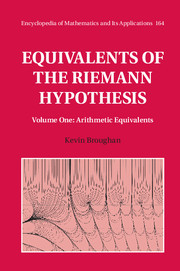Description
Equivalents of the Riemann Hypothesis: Volume 1, Arithmetic Equivalents
Encyclopedia of Mathematics and its Applications Series
Author: Broughan Kevin
This first volume of two presents classical and modern arithmetic equivalents to the Riemann hypothesis. Accompanying software is online.
Language: English
Subject for Equivalents of the Riemann Hypothesis: Volume 1...:
Approximative price 141.33 €
In Print (Delivery period: 14 days).
Add to cart
Publication date: 11-2017
Support: Print on demand
Support: Print on demand
Description
/li>Contents
/li>Biography
/li>
The Riemann hypothesis (RH) is perhaps the most important outstanding problem in mathematics. This two-volume text presents the main known equivalents to RH using analytic and computational methods. The book is gentle on the reader with definitions repeated, proofs split into logical sections, and graphical descriptions of the relations between different results. It also includes extensive tables, supplementary computational tools, and open problems suitable for research. Accompanying software is free to download. These books will interest mathematicians who wish to update their knowledge, graduate and senior undergraduate students seeking accessible research problems in number theory, and others who want to explore and extend results computationally. Each volume can be read independently. Volume 1 presents classical and modern arithmetic equivalents to RH, with some analytic methods. Volume 2 covers equivalences with a strong analytic orientation, supported by an extensive set of appendices containing fully developed proofs.
1. Introduction; 2. The Riemann Zeta function; 3. Estimates; 4. Classical equivalences; 5. Euler's Totient function; 6. A variety of abundant numbers; 7. Robin's theorem; 8. Numbers which do not satisfy Robin's inequality; 9. Left, right and extremely abundant numbers; 10. Other equivalents to the Riemann hypothesis; Appendix A. Tables; Appendix B. RHpack mini-manual; Bibliography; Index.
Kevin Broughan is Emeritus Professor in the Department of Mathematics and Statistics at the University of Waikato, New Zealand. In these two volumes he has used a unique combination of mathematical knowledge and skills. Following the publication of his Columbia University thesis, he worked on problems in topology before undertaking work on symbolic computation, leading to development of the software system SENAC. This led to a symbolic-numeric dynamical systems study of the zeta function, giving new insights into its behaviour, and was accompanied by publication of the software GL(n)pack as part of D. Goldfeld's book, Automorphic Forms and L-Functions for the Group GL(n,R). Professor Broughan has published widely on problems in prime number theory. His other achievements include co-establishing the New Zealand Mathematical Society, the School of Computing and Mathematical Sciences at the University of Waikato, and the basis for New Zealand's connection to the internet.
© 2024 LAVOISIER S.A.S.
These books may interest you

Riemann Surfaces 73.84 €


